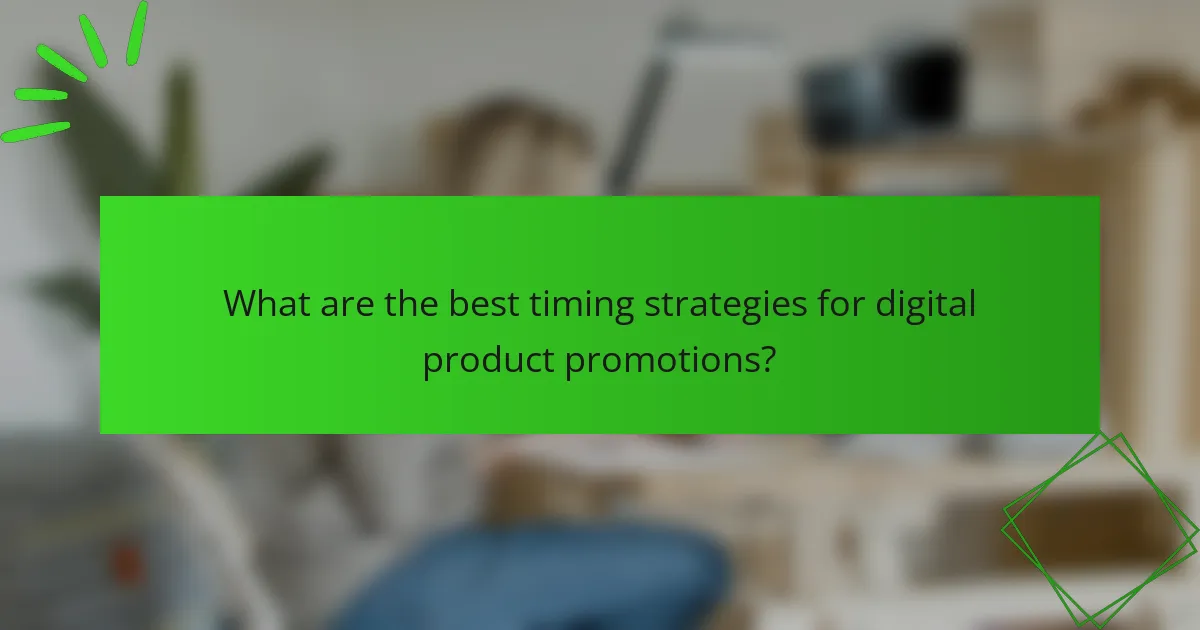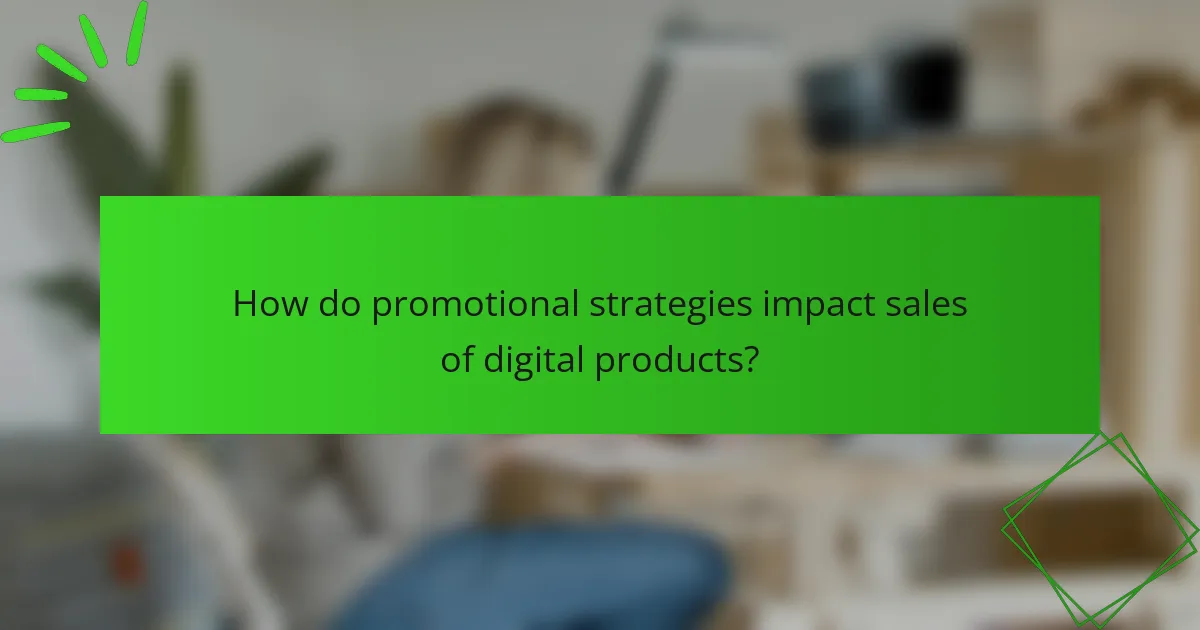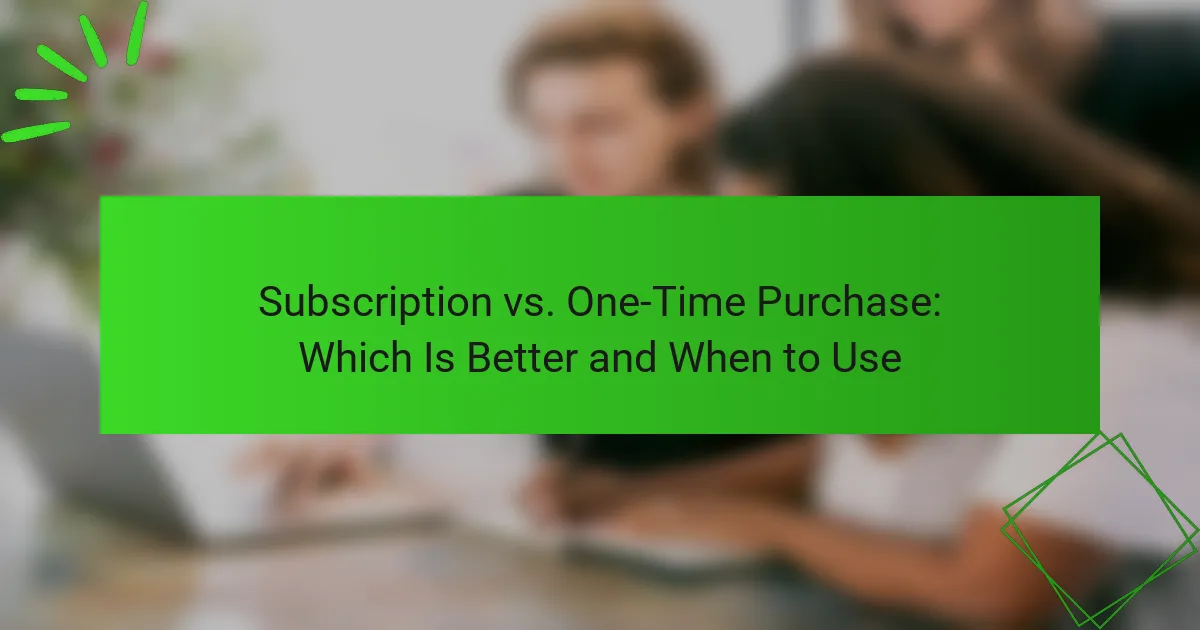In the competitive landscape of digital products, implementing effective discounts and promotions is crucial for driving sales and engaging customers. By aligning discount types and timing with customer behavior and market trends, businesses can maximize their promotional impact. Strategic timing, such as capitalizing on holiday sales or end-of-month offers, can further enhance visibility and conversions.

How to effectively use discounts for digital products in Canada?
To effectively use discounts for digital products in Canada, consider strategies that appeal to your target audience while maximizing sales. Focus on the type of discount, timing, and how it aligns with customer behavior to drive engagement and conversions.
Percentage-based discounts
Percentage-based discounts are a straightforward way to attract customers by offering a specific reduction on the product price. Common ranges for digital products in Canada can be between 10% to 50%, depending on the product’s value and market demand.
When implementing percentage discounts, ensure they are clearly communicated. For example, a 20% discount on a $50 product results in a $10 savings, making it appealing. However, avoid excessive discounts that may devalue your product.
Bundle offers
Bundle offers involve grouping multiple digital products together at a reduced price, encouraging customers to purchase more. This strategy can increase the average order value and provide perceived value to the customer.
For instance, offering a software suite at a 30% discount when purchased as a bundle compared to individual purchases can entice buyers. Ensure that the bundled products are complementary to enhance the customer experience.
Seasonal promotions
Seasonal promotions leverage holidays or events to create urgency and boost sales. In Canada, consider aligning discounts with major holidays like Black Friday, Cyber Monday, or Canada Day to attract attention.
For effective seasonal promotions, plan ahead and create marketing campaigns that highlight the limited-time nature of the discounts. A well-timed 25% off during a holiday can significantly increase traffic and sales, especially if paired with targeted advertising.

What are the best timing strategies for digital product promotions?
The best timing strategies for digital product promotions involve understanding customer behavior and market trends. Key strategies include launching products at optimal times, leveraging holiday sales periods, and offering end-of-month discounts to maximize visibility and sales.
Launch timing
Choosing the right launch timing is crucial for the success of digital products. Consider launching during peak online shopping periods, such as weekends or evenings, when potential customers are most active. Additionally, aligning product launches with industry events or trends can enhance visibility.
For example, if you are releasing a new software tool, consider timing it with relevant tech conferences or product updates. This can create buzz and attract early adopters who are already engaged in the topic.
Holiday sales periods
Holiday sales periods present significant opportunities for digital product promotions. Major holidays like Black Friday, Cyber Monday, and Christmas often see increased consumer spending, making them ideal for discounts and special offers. Tailoring promotions to these occasions can drive traffic and boost sales.
Consider creating themed bundles or limited-time offers that resonate with holiday shoppers. For instance, a fitness app could offer a New Year’s resolution discount to encourage users to start their fitness journey.
End-of-month discounts
End-of-month discounts can effectively stimulate sales as customers look to make purchases before the month closes. This strategy can create a sense of urgency, prompting consumers to act quickly to take advantage of limited-time offers. Offering a discount or bonus for purchases made at the end of the month can help clear inventory and increase cash flow.
For example, a subscription service might offer a 20% discount on renewals made before the end of the month, encouraging users to commit to their service for another term. This tactic not only boosts sales but also fosters customer loyalty.

How do promotional strategies impact sales of digital products?
Promotional strategies significantly boost sales of digital products by attracting new customers and encouraging repeat purchases. Effective promotions can create urgency and enhance perceived value, leading to increased sales volume and revenue.
Increased customer engagement
Promotional strategies foster increased customer engagement by capturing attention and encouraging interaction. For example, limited-time offers or discounts can prompt customers to explore products they might not have considered otherwise.
Engagement can also be enhanced through social media campaigns that promote digital products. By creating shareable content or running contests, businesses can generate buzz and encourage customers to participate actively.
Higher conversion rates
Promotional strategies often lead to higher conversion rates by reducing barriers to purchase. For instance, offering discounts or free trials can entice hesitant customers to make a decision, turning potential buyers into actual sales.
Additionally, clear calls-to-action combined with time-sensitive promotions can create a sense of urgency. This urgency encourages customers to act quickly, often resulting in a significant boost in conversion rates during promotional periods.
Long-term customer loyalty
Implementing effective promotional strategies can cultivate long-term customer loyalty. When customers feel they receive value through discounts or exclusive offers, they are more likely to return for future purchases. This loyalty can be reinforced through personalized promotions based on previous buying behavior.
Moreover, loyalty programs that reward repeat purchases with discounts or points can keep customers engaged over time. By consistently providing value, businesses can transform one-time buyers into loyal advocates for their digital products.

What criteria should be considered when planning discounts?
When planning discounts, it’s essential to consider factors such as your target audience, competitor pricing strategies, and the overall market conditions. These criteria help ensure that your promotions are effective and align with your business goals.
Target audience analysis
Understanding your target audience is crucial for effective discount planning. Analyze their purchasing behavior, preferences, and price sensitivity to tailor discounts that resonate with them. For example, younger consumers may respond better to digital promotions, while older demographics might prefer traditional sales.
Consider segmenting your audience based on demographics or buying habits. This allows for more personalized discount strategies, such as offering exclusive deals to loyal customers or seasonal promotions that appeal to specific groups.
Competitor pricing strategies
Monitoring competitor pricing strategies is vital for positioning your discounts effectively. Keep an eye on their promotional offers, discount rates, and timing to ensure your pricing remains competitive. For instance, if a competitor is offering a significant discount during a holiday season, you may need to adjust your strategy accordingly.
Utilizing tools for price tracking can help you gather data on competitor pricing trends. This information can guide your discount decisions, ensuring that your offers are attractive without compromising your profit margins. Aim for discounts that are compelling but still sustainable for your business.

How to measure the effectiveness of promotions for digital products?
To measure the effectiveness of promotions for digital products, track key performance indicators (KPIs) such as sales volume, conversion rates, and customer engagement metrics. Analyzing these metrics helps determine which promotional strategies yield the best results and inform future marketing efforts.
Sales data analysis
Sales data analysis involves examining the sales figures before, during, and after a promotion to assess its impact. Look for trends in sales volume, average transaction value, and customer acquisition rates. Comparing these metrics against previous periods can reveal the effectiveness of specific promotions.
Consider segmenting your sales data by product type or customer demographics to gain deeper insights. For instance, if a discount on a specific digital product led to a significant increase in sales among a particular age group, this information can guide future promotional strategies.
Customer feedback collection
Collecting customer feedback is essential for understanding the perceived value of promotions. Use surveys, reviews, and social media interactions to gather insights on customer satisfaction and their response to promotional offers. This qualitative data can complement your sales analysis.
Encourage feedback through incentives, such as offering a small discount on future purchases for completing a survey. Analyzing this feedback can help identify strengths and weaknesses in your promotional strategies, allowing for adjustments that better meet customer expectations.

What are the emerging trends in digital product promotions?
Emerging trends in digital product promotions focus on personalization, advanced pricing techniques, and subscription models. These strategies aim to enhance customer engagement and optimize revenue by tailoring offers to individual preferences and behaviors.
Personalized discounts
Personalized discounts are tailored offers based on customer data, preferences, and purchase history. By analyzing user behavior, businesses can create targeted promotions that resonate with specific segments, increasing the likelihood of conversion.
For example, a digital music service might offer a discount on a subscription renewal to users who frequently listen to a particular genre. This approach not only boosts sales but also fosters customer loyalty.
To implement personalized discounts effectively, businesses should invest in customer relationship management (CRM) tools and data analytics to track user interactions and preferences. Avoid generic promotions that fail to connect with individual customers.
AI-driven pricing strategies
AI-driven pricing strategies utilize algorithms to analyze market trends, competitor pricing, and consumer behavior in real-time. This allows businesses to dynamically adjust prices based on demand fluctuations, maximizing profitability.
For instance, an e-commerce platform may lower prices during off-peak hours to stimulate sales or increase them during high-demand periods. This flexibility can lead to significant revenue gains when executed correctly.
When adopting AI-driven pricing, ensure that the algorithms are regularly updated and monitored to avoid pricing errors. Businesses should also communicate transparently with customers about pricing changes to maintain trust.
Subscription-based models
Subscription-based models offer customers access to digital products for a recurring fee, providing predictable revenue streams for businesses. This approach has gained popularity across various sectors, including software, streaming services, and online education.
For example, a software company might offer a monthly subscription that includes regular updates and customer support, appealing to users who prefer lower upfront costs. This model can enhance customer retention and lifetime value.
To succeed with subscription-based models, businesses should focus on delivering consistent value and regularly engaging with subscribers. Avoid overcomplicating subscription tiers, as simplicity often leads to higher conversion rates.










